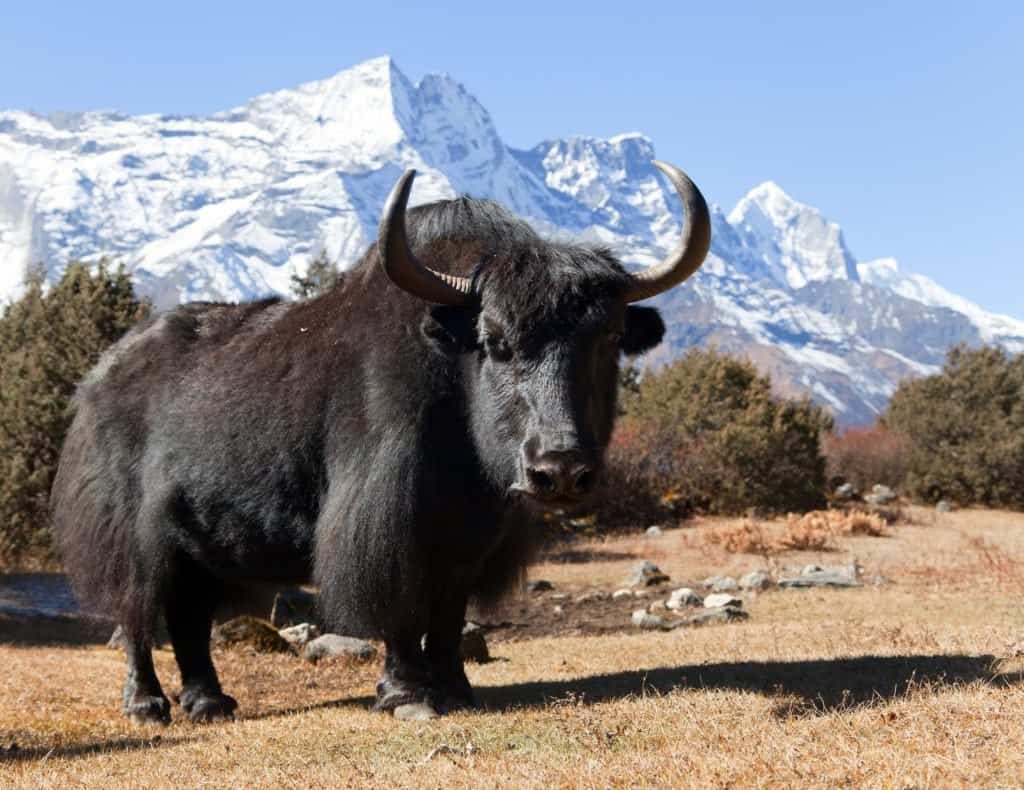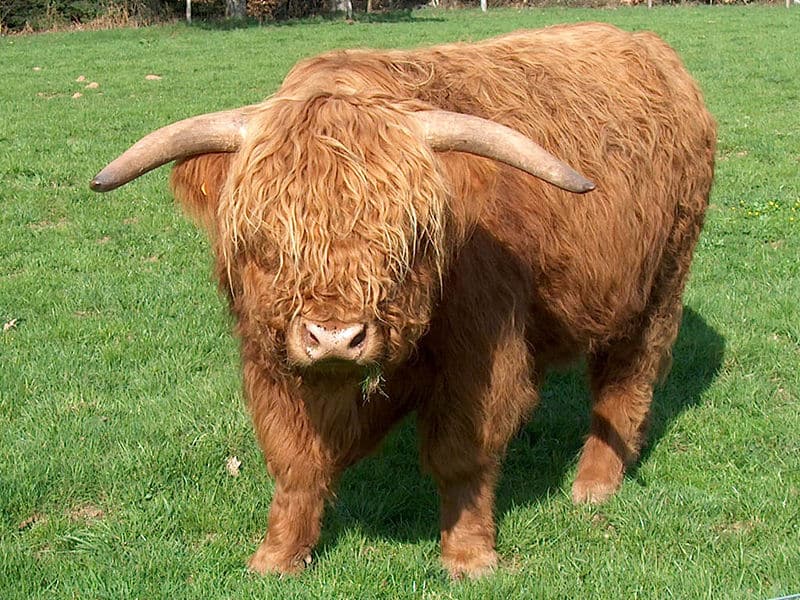When people first see a yak, they often think they are just furry cows! While yaks are furry and related to cows, the highland cow is already a breed of cow known for its fluffy appearance. Although the two appear related, they are quite different. Let’s explore: Yak vs Highland Cow; what makes them unique?
Comparing a Yak and a Highland Cow

| Yak | Highland cow | |
|---|---|---|
| Size | Domestic: 770-1,300 lbs Wild: 2,200 lbs | Males: 1400 lbs Females: 992 |
| Native habitat | Tibetan mountains | Scottish highlands |
| Hair color | Wild: Black, brown Domestic: Brown, cream, black | Mostly reddish-brown, occasionally yellow, pale silver, or black |
| Hair type | Thick, dense fur that extends around them in a skirt. Thick layer of subcutaneous fat. | Wooly, fluffy, double-layered. Little subcutaneous fat. |
| Domestication uses | Milk, meat, fiber, beast of burden. | Milk, meat. |
| Wild populations | Wild populations numbering around 15,000. | No wild population. Totally domesticated. |
The 6 Main Differences Between a Yak and a Highland Cow

Highland cows were bred in Scotland.
©attilio pregnolato/Shutterstock.com
The main difference between a yak and a highland cow is that a yak is a domesticated bovine from the Himalayas, while highland cows are a breed of domesticated cattle that were bred in Scotland. Additionally, yaks have wild populations, while highland cows only exist in human captivity.
Yaks and all cows are closely related, although they do have some differences that set them apart. When it comes to domesticated cattle, the highland cow may be the most similar in appearance to the yak, and both are adapted to similar environments. The modern yak split as a species from the wild auroch around 5 million years ago, while the modern cow was domesticated directly from aurochs around 10,500 years ago.
Yaks are essential animals for people groups native to the Himalayas and are used for meat, milk, fiber, and as beasts of burden. Highland cows are also used for meat and milk, but their hair isn’t as suitable for spinning as yak fibers are. The highland cow has its roots in the highlands of Scotland, with many of its features a reflection of its environment.
Let’s explore some of the differences between yaks and highland cows in detail!
Yak vs Highland Cow: Size

Highland cows are larger than domesticated yaks but smaller than wild yaks.
©Michail_Vorobyev/Shutterstock.com
Although both animals are close in size, the yak is slightly smaller than the average highland cow. Adult, domesticated yaks generally weigh up to 1,300 lbs. The females weigh slightly less, generally around 550 lbs. Wild yaks, however, are extremely large, sometimes weighing as much as 2,200 lbs.
Many breeds of cattle are heavier than yaks, although most of them are roughly equal in height. The highland cow is a larger breed of cow that is known to average around 1,400 lbs, but they can get much larger. Most females weigh around 1,000 lbs.
Yak vs Highland Cow: Native habitat

Highland cows are native to Scotland while yaks are native to the Himalayas.
Yaks are native to the Himalayan mountains and were domesticated around the Tibetan Plateau. Domesticated yaks are an important resource for people groups that live across the Tibetan Plateau, Northern Myanmar, Yunnan, Sichuan, Mongolia, and Siberia. Additionally, domestic yaks have small farm populations in the United States, Canada, New Zealand, and some parts of Europe. Wild yaks are still alive, although their population is dwindling. There are around 15,000 wild yaks still alive, with about half living in the Changtang National Nature Reserve in Tibet.
The highland cow is a breed of cattle that originates from the Hamitic longhorn cow that was bred in Egypt. Neolithic farmers brought these cows into Britain between the years 2000 and 1000 BC. The highland cow was bred for adaptation to the cold, rainy conditions of the Scottish highlands and was an important part of daily life for native people. Although these cows originated in Scotland, they are present all over the world after breeding stock was exported in the 20th century.
Yak vs Highland Cow: Hair color

Yaks are generally brown, black, and cream and often have a mix. The majority of highland cows are reddish-brown.
©Daniel Prudek/Shutterstock.com
Both yaks and highland cows have dense hair, but they generally have a few colors that they come in. Wild yaks are usually brown or black with little to no patterning across their bodies. Domestic yaks are more varied, coming in brown, black, cream, roan, and grey. Additionally, domestic yaks often have colored patterns that can vary widely.
Highland cows have a particular gene expression caused by the MC1R gene and the PMEL or SILV gene. These melanin-related genes produce red pigments, and 60% of all highland cows are reddish-brown in color. 22% can come in yellow, while the remainder can be silver or black.
Yak vs Highland Cow: Hair type

Highland cows have a double coat and wavy hair. Yaks have a double coat that usually looks like a skirt.
©Mahaba – Public Domain
The different types of hair that the yak and highland cow have are representative of the habitats that these animals come from. Yaks have dense fur that hangs down across their body, usually lower than their belly (a skirt). Additionally, they have a dense, wooly undercoat and a thick layer of subcutaneous fat that help them survive the freezing temperatures that are common along the world’s highest mountain range.
The highland cow also has a dense and furry coat, but theirs appears fluffier and wavier than the yak. These cows have a double coat of hair (uncommon among most cattle breeds) that can be divided into an oily outer layer and a downy undercoat. The oily outer coat helps the animal stay dry in the heavy rainfall that is common across Scotland.
Yak vs Highland Cow: Domestication uses
The yak is heavily relied upon by natives across the Himalayan range as a source of meat, milk, fiber, and labor. Since its domestication, the yak has been the essential pack and resource animal for these high-altitude groups, even to this day. Yak milk is turned into cheese (called chhurpi), and butter, and many cultural festivals exist around these resources. Butter tea and butter sculptures are common for many Tibetan festivals and ceremonies. Additionally, yak hair is spun and used to make clothing, tents, blankets, and rope. Yaks are also used as pack animals and are highly adept at traveling across harsh terrain with heavy loads. Even more, yak droppings are an essential fuel source for fires where there are no trees! These animals provide quite a lot to native people who know how to use them.
Highland cows are also an important resource for farmers in the UK. They were historically a source of meat and milk, but today are mostly used for meat. Since they can range across habitats that other cattle would find inhospitable, the highland cow can turn a profit from land that is generally considered unusable. Although they have thick hair, it is difficult to separate the outer and inner layers, and people don’t generally use it as a quality fiber.
Yak vs Highland Cow: Wild populations

There are wild populations of yaks, but no wild populations of cows.
©SakSa/Shutterstock.com
Today, the domesticated yak is prevalent across much of the Tibetan Plateau and throughout the Himalayas. Additionally, wild yak populations exist between 4,000 and 6,100 meters of elevation in the grasslands and cold desert regions across the Tibetan Plateau. Sadly, wild yaks are vulnerable and have a mere 15,000 individuals remaining in their native range.
The highland cow is a domesticated cattle breed that is fully reliant on humans. The ancient wild ancestors of modern cattle are the auroch. No wild cattle currently exist in the world.
The photo featured at the top of this post is © Olga Eromenko/Shutterstock.com
Thank you for reading! Have some feedback for us? Contact the AZ Animals editorial team.






